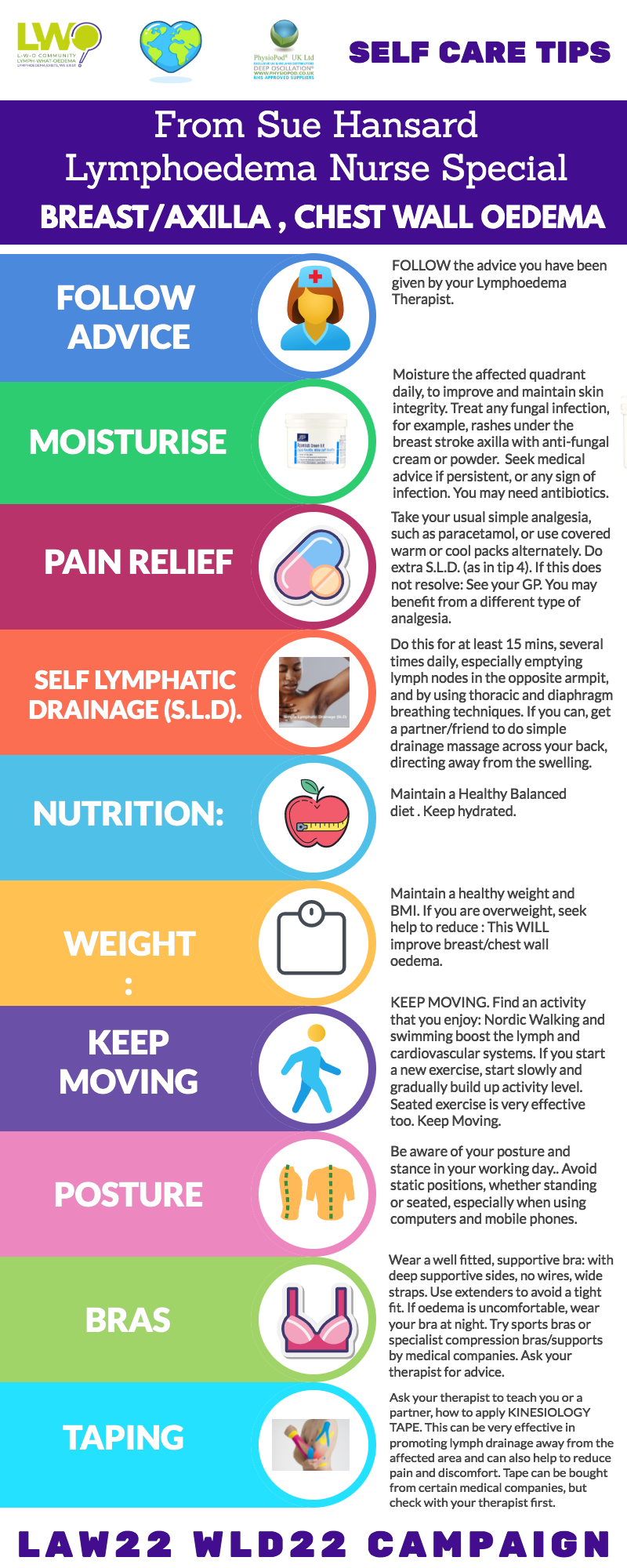Self Care Advice For Breast, Chest Wall, Axilla Oedema- Sue Hansard, Lymphoedema Nurse Specialist
For our joint campaign LWO Community and PhysioPod UK were delighted to receive the following top ten tips..
Sue Hansard is a Lymphoedema Nurse Specialist at First Lymph Care.
Sue also added the following very helpful information:
FIRSTLY: If you think you have developed Lymphoedema in the breast, chest wall, axilla..... DON’T PANIC.
Breast Lymphoedema, if assessed, diagnosed and treated promptly can resolve completely and can be reduced to self management levels similarly to limb Lymphoedema .
WHAT IS IT?
Put simply: swelling in the breast tissue, or the chest wall which occurs after trauma or infection or following treatment for breast cancer. It occurs more frequently following removal of lymph nodes and /or radiotherapy or less commonly after chemotherapy.
WHAT DOES IT LOOK LIKE?
The affected area is the operated side of the chest, including breast, chest,
armpit and the upper back on the operated side.
Any of these areas may be visibly swollen, may feel soft, or firm and feel tender/sore. The skin may be pink/red and may appear tight or dimpled like orange peel. There may be a dull ache or sharp pain, pins and needles, tingling or numbness all due to damaged nerves and the pressure of fluid within the tissues which aggravate the nerve endings.
It is vital that you are assessed by a Lymphoedema specialist who can advise , treat and teach you appropriately.
Your Lymphoedema therapist. will ultimately be aiming to reduce your swelling , reduce your pain, improve skin and show you how to confidently self- manage it in the longer term.
MY TOP 10 TIPS FOR SELF MANAGEMENT
INFOGRAPHIC

Finally. Have confidence that with these well tried techniques and the expert advice of your therapist you will be able to greatly improve your oedema. .
Lymph nodes do not regrow, and you may experience some residual tendency to swelling
for example, in hot or cold weather or if you are unwell you may find that the area becomes a little more swollen: just increase you S.L.D, and other strategies and it will ease again.
Neuropathic symptoms: soreness, itching, tingling, numbness may not fully resolve because damaged nerves do not re grow BUT don’t worry, if you use the strategies that you now have in your toolbox: pain relief, exercise, cool/warm packs, support.and self massage you will be able to improve and manage your condition.
BE CONFIDENT in your SELF CARE as you MOVE FORWARD... and KEEP MOVING.
SUE HANSARD

